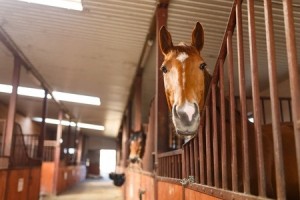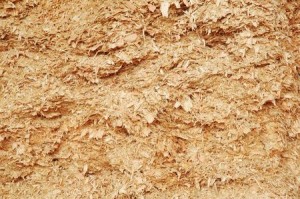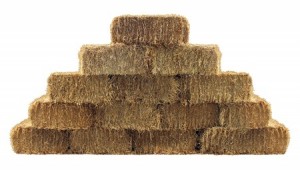
If you are one of the many people who keeps your horse at your home property, you’ve probably spent some time trying to decide what is the best type of bedding for your horse. There are quite a few options available today – from wood based products such as shavings and wood pellets, to straw bedding, rubber mats, and other alternative choices that are available depending on your geographical location. Every horse is different and the type of stall bedding that you choose will really depend on your horse’s individual needs such as allergies to dust, or how much time he spends in his stall. Here are some of the more popular equine bedding materials and things to consider when selecting what type of bedding would work best for you and your horse.
Availability
One of the biggest factors in selecting the best type of bedding for your horse is to determine what options are available in your area. In some parts of the country, wood shavings or pellets may be the most popular choice, while rice hulls or paper bedding might be easier to find in other geographical locations. Ask some of your neighbors and check with your local feed store to see what is most widely used in your area.
Nervous Horse? – It could be a nutritional deficiency
Dust
If either you or your horse has respiratory issues or allergies, then you’re going to want to use stall bedding that has little or no dust. Depending on what you can find in your area, there are several dust free products including special wood shavings that are kiln dried and dust free. Your vet is an excellent resource and can work with you on suitable bedding material if your horse has respiratory problems.
Storage and Disposal
The storage and disposal of stall bedding is also a big consideration, especially if you have small land space or small or limited storage rooms. If you plan on buying your bedding in bulk, you’ll need to have sufficient storage for the materials in an area that is well protected from the sun, rain and wind. If you decide to buy your bedding in bags or bales, you’ll still need to have a place where you can store them that is easily accessible and is also well protected from the weather. In terms of disposal, you’ll need to decide if you can manage the waste yourself either by composting or hauling, or if you’ll need to have the used material removed by a waste disposal company.
Comfort and Absorbency
One of the main purposes of stall bedding is to quickly and efficiently absorb urine and moisture, as you do not want your horse standing on wet bedding and exposed to ammonia odors (this could be damaging to his lungs). You also want the bedding to be soft, cushiony and comfortable for your horse especially if your horse is a senior or if he’s in his stall for long periods of time. If your horse is kept in a stall with little or no turn out area, you’ll need to provide a type of stall bedding that is highly absorbent as well as soft and comfortable, especially since his bedding is going to be used a lot more than a horse that has a large turnout area and is in his stall for only a couple of hours a day.
Palatability
The palatability of the bedding is another factor you should consider when you are trying to select the best type of bedding for your horse. Some horses will eat wood shaving or straw bedding while other horses show little or no interest in their bedding material. Try testing out small samples of different types of bedding to see what your horse is or is not interested in before you make your selection.
Common Types of Bedding
Probably the most popular products used for horse bedding are wood products such as wood shavings, wood pellets, wood chips and sawdust, though there are many other products available that are also used for bedding horse stalls.
Wood Shavings
Wood shavings are a very popular choice since they are soft, highly absorbent and easy to clean out of the stall. The most popular type of wood used in shavings comes from pine and can vary in size from large, fluffy shavings to smaller, finer size shavings. You can save money if you buy loose shavings in bulk, but you’ll need to have a large covered storage area where you can keep it safely stored away from the wind, rain and dust. Another option is to buy bagged shavings that are easy to handle, easy to store, and typically less dusty than loose shavings. While wood shavings are used for a variety of purposes, it’s important that you use shavings in your horses’ stall that are produced specifically for horse bedding. Some wood products, such as black walnut, are toxic to horses so you’ll need to be care in selecting wood shavings that are specifically used for horse stalls. Almost all feed stores will carry a selection of bagged wood shavings that are made just for horse stalls and they can help you select what type is best suited for your set up. If you decide to use shavings in your horse’s stall, the wet shavings will need to be constantly removed and cleaned from the stall to avoid the buildup of ammonia, and you’ll need to have a place where you can dispose of the soiled bedding. Most horses are generally not interested in eating shavings, although there are exceptions where some horses may find them tasty. You’ll need to test your horse first to see if he’s interested in eating shavings before you decide to bed his entire stall. Wood shavings are one of the best bedding choices for your horse, but they should not be used if you have a mare that is going to foal (straw is a better bedding solution in this case).
Wood Pellets
Pelleted wood bedding is available in small size bags that are easy to haul and easy to store. Wood pellets are made of kiln-dried wood that is compacted into hard, compressed pellets and are highly absorbent. Wood pellets are a good choice for stall bedding, as the pellets are initially sterilized (which reduces bacteria) plus there is very little ammonia odor from the urine. Wood pellets typically are not dusty and they are fairly easy to clean from the stall since you only need to remove the wet spots and then add fresh, new pellets to replace what you have removed. If you decide to use wood pellets, you will need to sprinkle water on the pellets first to help soften them so they can expand into soft, fluffy bedding. One drawback to wood pellets is they are typically expensive and usually are not used in cold climates since the pellets cannot be wet down without the water freezing. Just like with wood shavings, wood pellets are used for a variety of purposes, so make sure that you are using wood pellets that are designed specifically for horse bedding.
Wood Chips
Wood chips are another choice people may use for bedding their horse stalls. Chips are not as absorbent as the other wood products like shavings or pellets, though they still will absorb some urine. Wood chips can sometimes be coarse or even uncomfortable to the horse depending on the quality and size of the chips.
Does your horse need Joint Support?
Sawdust
Sawdust is another wood product some people use for horse bedding. Sawdust is typically inexpensive and is readily available in many areas. As with the other wood type bedding materials, it needs to be stored in a covered area away from the wind and rain. Sawdust, though, generally has a lot of dust which can irritate your horse’s eyes and nose especially when your horse is walking around his stall. Sawdust is definitely not recommended for people or horses that have respiratory issues.
Straw
Straw has a long history of being used as bedding in horse stalls and is typically easy to find in most areas of the country. Straw comes from cereal grains such as wheat, barley and oat, with wheat being the most common type that is used for stall bedding. Although straw may not be as absorbent as wood based products such as shavings or wood pellets, it is still a good bedding choice for your horse. Stalls that are deeply bedded with straw can effectively keep the moisture level down by creating a protective barrier or “mat” between the horse and the urine. By using a thick layer of straw, the urine is able to soak through the bedding and then settle to the bottom of the stall floor. If you decide to use straw for bedding, you’ll want to purchase straw that is sweet smelling and free of mold or foreign materials. Also, you’ll need to have a dry, covered area where you can safely store it away from the rain and dust. Stalls that are bedded with straw need to be cleaned frequently and you’ll need to replace the soiled straw with fresh, clean straw so that your horse is not exposed to ammonia, dust or spores. During the winter time, you’ll probably want to add some extra straw bedding for additional warmth and comfort. Also, if you have a mare in foal, you’ll want to use straw bedding since it is soft and cushiony and will not stick to the mare or foal. The disadvantage of using straw for bedding, however, is that straw can be tasty to horses which could be a problem if your horse eats too much (which could lead to colic) or if he’s on a diet to lose weight. You’ll want to test a small amount with your horse first to see if he’s interested in eating the straw before you decide to use it as your bedding choice.
Rice Hulls
Rice hulls, which are used in some regions, can be purchased either in bulk or in prepackaged bags. Rice hulls are light weight and although they are not very absorbent, they are great to use in stalls that have good drainage or if they are mixed with another bedding material such as wood shavings. Rice hulls are dust free, soft and cushiony, so they can provide good bedding comfort for your horse. However, since they are light weight, they are not very effective if the stalls are open and exposed to windy conditions. Most horses are not interested in consuming rice hulls, but it’s best to test your horse first to see if he’s interested in eating them.
Stall Mats
Rubber stall mats are often used in stalls, although most people will add a layer of extra bedding such as shavings or straw on top of the mats for additional comfort. One of the best features about stall mats is that they are easy to clean and provide a cushiony barrier from the hardness of a stall floor. Stall mats are not absorbent and they can be slippery when soiled and wet, so adding a light layer of alternate bedding, such as wood shavings, would be advisable if you decide to use stall mats. The initial cost of stall mats may be pricey, but in the long run you will be saving in stall bedding costs plus you will need less storage for bedding materials. If you decide to use stall mats, you’ll want to remove them occasionally and thoroughly clean them off with soap and water.
Paper Shavings
Some people like to use paper shavings as bedding for their horses; they are dust-free and highly absorbent, so this could be a good choice for horses with allergies. Paper shavings are available in both bales or in bags and are easy to store as long as they are kept in an area that is protected from rain or wind. A big plus to using paper shavings is that horses generally are not interested in eating this type of bedding, though just like with the other types of bedding materials, you’ll need to test a small pile to see if your horse shows any interest in eating it. If you decide to use paper shavings in your stalls, you’ll need to make sure the stalls have good insulation from the wind as this type of material will easily blow away. The downside to using paper for horse stall bedding is that the paper will get heavy and slippery when soiled, so you’ll need to pay extra attention to keeping your horse’s stall dry and clean. Another disadvantage is that paper will mat together when it’s wet, which will cut down on the cushiony effect that the other bedding choices will provide.
These are just a few choices of material that you can use as bedding for your horse, though there are quite a few other materials that are commonly used in horse stalls. Trying to find the best type of bedding for your horse can be a process of trial and error, so if you don’t like one type of bedding you can always switch over and try another type. The main idea is to make sure that your horse has comfortable, soft bedding that is clean, relatively dust free and is also absorbent. What is your favorite type of stall bedding?








David says
Hi, What about hemp? Any ideas? I head its supposed to be good as dust free too
Robert says
Has anyone used or heard of the bedding based on coconut husks?
Lars Pardo says
great question – wish I knew the answer…but I would think that it’s important to consider not just comfort for the animals and urine absorption but if the bedding composts easily…
Cheree Douglas says
I use mats with very fine shavings. Seems to work well. They are absorbent and easily removed from the stall without losing too much beding.
Barb Anderson says
I have a 30’x40’ area with hard clay dirt for my horse & goat. The corral floor is hard clay until it rains. Noni has problems with laminitis and her feet do well on the grass area but I need her to stay in the corral mostly. What do you think would be the best covering that won’t break the bank? Thanks.
Rose Marie says
Too many miss spelled words last text. Is removing wood stall floor and fill with Potting soil and sand mix.; This will be same height as connecting tack space with wood floor Thank you
Rose Marie says
My son has said best bedding is remove wood and fill with peat moss and dust less sand. Is this theme best? No wood. Only learnt moss. Potting soil mixed with dust less heavy sand. Miss this true and best?
KATRINA WOLFF says
We are building a new barn. We were thinking of pouring a concrete slab. Is this a good choice for horses? We have never had horses on our own property.
If not concrete, what other type of foundation is best for barns?
Karen says
A concrete slab for horse barn flooring is only acceptable if you put rubber stall mats on top. It is too hard and unyielding. Also, unless it is “broomed” while still wet it will be slippery for horses to walk on. Most barns have clay floors. some use crushed limerock and then bed over that with shavings of some type.
CAROL says
For centuries thick wood planking has been the choice for barn and stall flooring. Generally the planking is at least 2” thick and supported up off the earth by 4”x4” beams at least. Some have put heavy plywood down over the support beams, and this requires the support beams to be spaced 12” to 18” on centre to support the weight of horses/cattle long term. If I had the financial wherewithal to build a barn, I’d put in a solid wooden floor.
Diane Roetlin says
I live in Iowa
Do you know where I might buy dust-free shavings for horse bedding?
Thank you
Carl says
Farm and fleet. Third send and tractor supply
Hoyt Carl says
Thiessens
CAROL says
For centuries thick wood planking has been the choice for barn and stall flooring. Generally the planking is at least 2” thick and supported up off the earth by 4”x4” beams at least. Some have put heavy plywood down over the support beams, and this requires the support beams to be spaced 12” to 18” on centre to support the weight of horses/cattle long term. If I had the financial wherewithal to build a barn, I’d put in a solid wooden floor.
Oksana says
I use pine straw from my small wooded area it has a layer of turf like soil under it so I just rake it and put a thick layers in the stall amazingly it works nice and turf like matter is very absorbent while top layer is nice and dry plus I take it to my garden after use. Additionally horses started to poop in one area :) coincidence? I have 5 horses… all did
Susan Bellinger says
You do not mention peat moss?
I love it
Laura says
I’ve used sand mixed 75/25 mixed with peat in my stalls. Sand is cheap, and reusable if you compost the poo separately. Put the sand aside and let mother nature clean it for a few months, More if not enough rain and snow.
Pennie says
What is it about peat moss that you love? I am very interested. I think wood shavings are very hard to digest.
Susan bellinger says
Peat moss is very absorbent and i never have a urine smell. It is more expensive but lasts longer than other bedding.
It is good for the environment too.
Jennifer says
Personally I would not moldy anything near my horse. I understand that they will not be in direct contact but still. I have rubber mats on top of stone dust and that works great. If you place wood chips or shavings between the stone dust and mats, 1) the mats will not sit evenly, 2) the wood chips will eventually rot away and that will cause the uneven mats.
Renae says
You put the shavings on top of the mat Jennifer, not under it ????
Janine Callaghan says
Hello. I am busy building a lean to for my horse and for bedding I put a layer of rock, then crusher dust, to lift her sleeping area off the ground so water don’t run into it. Then I was thinking of putting a layer of wood chips, that has been sitting for a few moths in the rain from evergreens we had cut down after the storms, then the rubber mats. Will the wood chips go moldy under the mats and be harmful to my horse? Should I wait for the wood chips to dry out completely before u out the mats down? Tha nx:)
Kathi says
Do not put anything organic under the mats. It will eventually make a horrible, nasty mess.
CAROL says
Organic matter breaks down into soil. I personally would finish that flooring with sand over the rock, mats on top of the sand, and then wood shavings over the mats for comfort.